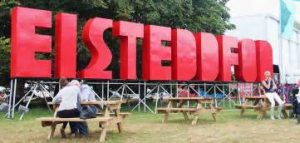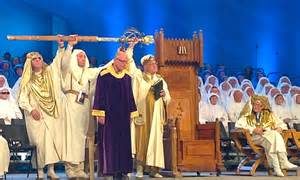The history of the eisteddfod in Wales goes back centuries and is a celebration of culture and music. This post is very quick guide to the annual National Eisteddfod.
Centuries old tradition
The tradition of holding an eisteddfod can be traced back to the 12th century. The Eisteddfod alternates between sites in North and South Wales and every year it creates excitement and interest in the specific area that it visits. This year a site in the open countryside is being used and everyone prays that it will be dry – otherwise the visitors will be wearing wellington boots.
It is also a great social occasion when old friends meet up, acquaintances renewed and new bonds established. There are hundreds of different tents on the field where different organisations can offer goods for sale or promote their cause.
Here is a link to the main Eisteddfod website.
The main events
There are two main events – the chairing of the bard. This is were a specially made chair is awarded to a piece of poetry written in strict metre form known as ‘cynghanedd.’ There is an interesting article on this in Wikipedia. The second highlight is the crowning of the bard. This is awarded for a piece of poetry not in strict metre.
 One of the most dramatic events in Eisteddfod history was the award of the 1917 chair to the poet Ellis Humphrey Evans, bardic name Hedd Wyn, for the poem Yr Arwr (The Hero). The winner was announced, and the crowd waited for the winner to stand up to accept the traditional congratulations before the chairing ceremony, but no winner appeared. It was then announced that Hedd Wyn had been killed the previous month on the battlefield in Belgium. These events were portrayed in the Academy Award nominated film Hedd Wyn. Lots more to read on Wikipedia.
One of the most dramatic events in Eisteddfod history was the award of the 1917 chair to the poet Ellis Humphrey Evans, bardic name Hedd Wyn, for the poem Yr Arwr (The Hero). The winner was announced, and the crowd waited for the winner to stand up to accept the traditional congratulations before the chairing ceremony, but no winner appeared. It was then announced that Hedd Wyn had been killed the previous month on the battlefield in Belgium. These events were portrayed in the Academy Award nominated film Hedd Wyn. Lots more to read on Wikipedia.
There is also a fine art exhibition which allows artist to show their work to a wide audience. Click here for the link.
There are other Eisteddfodau in Wales that all come from the same tradition of poetry and music competitions. One of the most famous internationally is the Llangollen eisteddfod which attracts participants from all over the world. The small Welsh town of Llangollen become a melting pot of different cultures and languages for a few days when the eisteddfod is held. The other eisteddfod is run by Urdd Gobaith Cymru which is a youth movement in Wales established to promote Welsh culture music and poetry and protect the language amongst young people.
I hope these links will give you a taste of the centuries of traditions that exists in Wales. If you’re in North Wales next week then do pay the Eisteddfod a visit.

